Spatiotemporal Distribution and Driving Force Analysis of the Ecosystem Service Value: A Typical Case Study of the Coastal Zone, Eastern China
Abstract
:1. Introduction
2. Materials and Methods
2.1. Study Area
2.2. Data Source and Preprocessing
2.3. Study Methods
2.3.1. Measurement of the ESV
2.3.2. Spatial Autocorrelation Analysis
- (1)
- Global Moran’s I
- (2)
- Local Moran’s I
2.3.3. Standard Deviation Ellipse
2.3.4. Driving Force Analysis Method
3. Results
3.1. Land Use Change Characteristics
3.2. ESV Change Characteristics
3.2.1. ESV Temporal Change Characteristics
3.2.2. ESV Spatial Change Characteristics
3.3. Driving Force of Spatial Heterogeneity in ESV
3.3.1. Factor Probe Analysis
3.3.2. Interaction Probe Analysis
4. Discussion
4.1. Land Use and ESV Change Analysis
4.2. Driving Factors on ESV Distribution
4.3. Limitations and Future Work
5. Conclusions
Author Contributions
Funding
Institutional Review Board Statement
Informed Consent Statement
Data Availability Statement
Acknowledgments
Conflicts of Interest
References
- Costanza, R.; De Groot, R.; Sutton, P.; Van der Ploeg, S.; Anderson, S.J.; Kubiszewski, I.; Farber, S.; Turner, R.K. Changes in the global value of ecosystem services. Glob. Environ. Chang. 2014, 26, 152–158. [Google Scholar] [CrossRef]
- Carlos, C.; Simon, H.; Mc Michael, A. Millennium Ecosystem Assessment (MEA), Ecosystems and Human Well-Being; World Resources Institute, Island Press: Washington, DC, USA, 2005. [Google Scholar]
- Lau, J.D.; Hicks, C.C.; Gurney, G.G.; Ginner, J.E. What matters to whom and why? Understanding the importance of coastal ecosystem services in developing coastal communities. Ecosyst. Serv. 2019, 35, 219–230. [Google Scholar] [CrossRef]
- Mehvar, S.; Filatova, T.; Dastgheib, A.; van Steveninck, E.d.R.; Ranasinghe, R. Quantifying Economic Value of Coastal Ecosystem Services: A Review. J. Mar. Sci. Eng. 2018, 6, 5. [Google Scholar] [CrossRef]
- Shiferaw, H.; Bewket, W.; Alamirew, T.; Zeleke, G.; Teketay, D.; Bekele, K.; Schaffner, U.; Eckert, S. Implications of land use/land cover dynamics and Prosopis invasion on ecosystem service values in Afar Region, Ethiopia. Sci. Total Environ. 2019, 675, 354–366. [Google Scholar] [CrossRef] [PubMed]
- Ligate, E.J.; Chen, C.; Wu, C. Evaluation of tropical coastal land cover and land use changes and their impacts on ecosystem service values. Ecosyst. Health Sustain. 2018, 4, 188–204. [Google Scholar] [CrossRef]
- Zhang, L.; Hu, B.; Zhang, Z.; Liang, G. Research on the spatiotemporal evolution and mechanism of ecosystem service value in the mountain-river-sea transition zone based on “production-living-ecological space”—Taking the Karst-Beibu Gulf in Southwest Guangxi, China as an example. Ecol. Indic. 2023, 148, 109889. [Google Scholar] [CrossRef]
- Costanza, R.; dArge, R.; deGroot, R.; Farber, S.; Grasso, M.; Hannon, B.; Limburg, K.; Naeem, S.; Oneill, R.V.; Paruelo, J.; et al. The value of the world’s ecosystem services and natural capital. Nature 1997, 387, 253–260. [Google Scholar] [CrossRef]
- Woldeyohannes, A.; Cotter, M.; Biru, W.D.; Kelboro, G. Assessing Changes in Ecosystem Service Values over 1985–2050 in Response to Land Use and Land Cover Dynamics in Abaya-Chamo Basin, Southern Ethiopia. Land 2020, 9, 37. [Google Scholar] [CrossRef]
- Stoeckl, N.; Condie, S.; Anthony, K. Assessing changes to ecosystem service values at large geographic scale: A case study for Australia’s Great Barrier Reef. Ecosyst. Serv. 2021, 51, 101352. [Google Scholar] [CrossRef]
- Hoque, M.Z.; Islam, I.; Ahmed, M.; Hasan, S.S.; Prodhan, F.A. Spatio-temporal changes of land use land cover and ecosystem service values in coastal Bangladesh. Egypt. J. Remote Sens. Space Sci. 2022, 25, 173–180. [Google Scholar] [CrossRef]
- Xie, G.; Zhen, L.; Lu, C. Expert knowledge based valuation method of ecosystem services in China. J. Nat. Resour. 2008, 23, 911–919. [Google Scholar]
- Kankam, S.; Osman, A.; Inkoom, J.N.; Fuerst, C. Implications of Spatio-Temporal Land Use/Cover Changes for Ecosystem Services Supply in the Coastal Landscapes of Southwestern Ghana, West Africa. Land 2022, 11, 1408. [Google Scholar] [CrossRef]
- Reed, D.C.; Schmitt, R.J.; Burd, A.B.; Burkepile, D.E.; Kominoski, J.S.; McGlathery, K.J.; Miller, R.J.; Morris, J.T.; Zinnert, J.C. Responses of Coastal Ecosystems to Climate Change: Insights from Long-Term Ecological Research. Bioscience 2022, 72, 871–888. [Google Scholar] [CrossRef]
- Aziz, T. Changes in land use and ecosystem services values in Pakistan, 1950–2050. Environ. Dev. 2021, 37, 100576. [Google Scholar] [CrossRef]
- Pham, K.T.; Lin, T.-H. Effects of urbanisation on ecosystem service values: A case study of Nha Trang, Vietnam. Land Use Policy 2023, 128, 106599. [Google Scholar] [CrossRef]
- Liu, Z.; Wang, S.; Fang, C. Spatiotemporal evolution and influencing mechanism of ecosystem service value in the Guangdong-Hong Kong-Macao Greater Bay Area. Acta Geogr. Sin. 2021, 76, 2798–2810. [Google Scholar] [CrossRef]
- Talukdar, S.; Singha, P.; Mahato, S.; Praveen, B.; Rahman, A. Dynamics of ecosystem services (ESs) in response to land use land cover (LU/LC) changes in the lower Gangetic plain of India. Ecol. Indic. 2020, 112, 106121. [Google Scholar] [CrossRef]
- Gashaw, T.; Tulu, T.; Argaw, M.; Worqlul, A.W.; Tolessa, T.; Kindu, M. Estimating the impacts of land use/land cover changes on Ecosystem Service Values: The case of the Andassa watershed in the Upper Blue Nile basin of Ethiopia. Ecosyst. Serv. 2018, 31, 219–228. [Google Scholar] [CrossRef]
- Maimaiti, B.; Chen, S.; Kasimu, A.; Mamat, A.; Aierken, N.; Chen, Q. Coupling and Coordination Relationships between Urban Expansion and Ecosystem Service Value in Kashgar City. Remote Sens. 2022, 14, 2557. [Google Scholar] [CrossRef]
- Zhang, X.; Shen, J.; Sun, F.; Wang, S. Spatial-Temporal Evolution and Influencing Factors Analysis of Ecosystem Services Value: A Case Study in Sunan Canal Basin of Jiangsu Province, Eastern China. Remote Sens. 2023, 15, 112. [Google Scholar] [CrossRef]
- Liu, Y.; Hou, X.; Li, X.; Song, B.; Wang, C. Assessing and predicting changes in ecosystem service values based on land use/cover change in the Bohai Rim coastal zone. Ecol. Indic. 2020, 111, 106004. [Google Scholar] [CrossRef]
- Mehvar, S.; Filatova, T.; Sarker, M.H.; Dastgheib, A.; Ranasinghe, R. Climate change-driven losses in ecosystem services of coastal wetlands: A case study in the West coast of Bangladesh. Ocean. Coast. Manag. 2019, 169, 273–283. [Google Scholar] [CrossRef]
- Penuelas, J.; Sardans, J.; Filella, I.; Estiarte, M.; Llusia, J.; Ogaya, R.; Carnicer, J.; Bartrons, M.; Rivas-Ubach, A.; Grau, O.; et al. Assessment of the impacts of climate change on Mediterranean terrestrial ecosystems based on data from field experiments and long-term monitored field gradients in Catalonia. Environ. Exp. Bot. 2018, 152, 49–59. [Google Scholar] [CrossRef]
- Shoko, C.; Mutanga, O.; Dube, T. Remotely sensed C3 and C4 grass species aboveground biomass variability in response to seasonal climate and topography. Afr. J. Ecol. 2019, 57, 477–489. [Google Scholar] [CrossRef]
- Liu, Y.; Liu, S.; Sun, Y.; Li, M.; An, Y.; Shi, F. Spatial differentiation of the NPP and NDVI and its influencing factors vary with grassland type on the Qinghai-Tibet Plateau. Environ. Monit. Assess. 2021, 193, 48. [Google Scholar] [CrossRef] [PubMed]
- Zhou, Y.; Ning, L.; Bai, X. Spatial and temporal changes of human disturbances and their effects on landscape patterns in the Jiangsu coastal zone, China. Ecol. Indic. 2018, 93, 111–122. [Google Scholar] [CrossRef]
- Magalhaes Filho, L.; Roebeling, P.; Villasante, S.; Bastos, M.I. Ecosystem services values and changes across the Atlantic coastal zone: Considerations and implications. Mar. Policy 2022, 145, 105265. [Google Scholar] [CrossRef]
- Lorilla, R.S.; Poirazidis, K.; Detsis, V.; Kalogirou, S.; Chalkias, C. Socio-ecological determinants of multiple ecosystem services on the Mediterranean landscapes of the Ionian Islands (Greece). Ecol. Model. 2020, 422, 108994. [Google Scholar] [CrossRef]
- Fang, L.; Wang, L.; Chen, W.; Sun, J.; Cao, Q.; Wang, S.; Wang, L. Identifying the impacts of natural and human factors on ecosystem service in the Yangtze and Yellow River Basins. J. Clean. Prod. 2021, 314, 127995. [Google Scholar] [CrossRef]
- Pan, N.; Guan, Q.; Wang, Q.; Sun, Y.; Li, H.; Ma, Y. Spatial Differentiation and Driving Mechanisms in Ecosystem Service Value of Arid Region: A case study in the middle and lower reaches of Shule River Basin, NW China. J. Clean. Prod. 2021, 319, 128718. [Google Scholar] [CrossRef]
- Chuai, X.; Huang, X.; Wu, C.; Li, J.; Lu, Q.; Qi, X.; Zhang, M.; Zuo, T.; Lu, J. Land use and ecosystems services value changes and ecological land management in coastal Jiangsu, China. Habitat Int. 2016, 57, 164–174. [Google Scholar] [CrossRef]
- Zhou, J.; Wu, J.; Gong, Y. Valuing wetland ecosystem services based on benefit transfer: A meta-analysis of China wetland studies. J. Clean. Prod. 2020, 276, 122988. [Google Scholar] [CrossRef]
- Xie, L.; Wang, H.; Liu, S. The ecosystem service values simulation and driving force analysis based on land use/land cover: A case study in inland rivers in arid areas of the Aksu River Basin, China. Ecol. Indic. 2022, 138, 108828. [Google Scholar] [CrossRef]
- Li, F.; Yin, X.; Shao, M. Natural and anthropogenic factors on China’s ecosystem services: Comparison and spillover effect perspective. J. Environ. Manag. 2022, 324, 116064. [Google Scholar] [CrossRef] [PubMed]
- He, Y.; Kuang, Y.; Zhao, Y.; Ruan, Z. Spatial Correlation between Ecosystem Services and Human Disturbances: A Case Study of the Guangdong–Hong Kong–Macao Greater Bay Area, China. Remote Sens. 2021, 13, 1174. [Google Scholar] [CrossRef]
- Xie, G.; Lu, C.; Leng, Y. Ecological assets valuation of the Tibetan Plateau. J. Nat. Resour. 2003, 18, 189–196. [Google Scholar]
- Luo, Q.; Zhang, X.; Li, Z.; Yang, M.; Lin, Y. The effects of China’s Ecological Control Line policy on ecosystem services: The case of Wuhan City. Ecol. Indic. 2018, 93, 292–301. [Google Scholar] [CrossRef]
- Long, X.; Lin, H.; An, X.; Chen, S.; Qi, S.; Zhang, M. Evaluation and analysis of ecosystem service value based on land use/cover change in Dongting Lake wetland. Ecol. Indic. 2022, 136, 108619. [Google Scholar] [CrossRef]
- Zhou, C.; Chen, J.; Wang, S. Examining the effects of socioeconomic development on fine particulate matter (PM2.5) in China’s cities using spatial regression and the geographical detector technique. Sci. Total Environ. 2018, 619–620, 436–445. [Google Scholar] [CrossRef]
- Zhou, Y.; Li, X.; Liu, Y. Land use change and driving factors in rural China during the period 1995–2015. Land Use Policy 2020, 99, 105048. [Google Scholar] [CrossRef]
- Wang, J.-F.; Li, X.-H.; Christakos, G.; Liao, Y.-L.; Zhang, T.; Gu, X.; Zheng, X.-Y. Geographical Detectors-Based Health Risk Assessment and its Application in the Neural Tube Defects Study of the Heshun Region, China. Int. J. Geogr. Inf. Sci. 2010, 24, 107–127. [Google Scholar] [CrossRef]
- Kulaixi, Z.; Chen, Y.; Wang, C.; Xia, Q. Spatial differentiation of ecosystem service value in an arid region: A case study of the Tarim River Basin, Xinjiang. Ecol. Indic. 2023, 151, 110249. [Google Scholar] [CrossRef]
- Zhou, Z.; Sun, X.; Zhang, X.; Wang, Y. Inter-regional ecological compensation in the Yellow River Basin based on the value of ecosystem services. J. Environ. Manag. 2022, 322, 116073. [Google Scholar] [CrossRef] [PubMed]
- Yang, R.; Ren, F.; Xu, W.; Ma, X.; Zhang, H.; He, W. China’s ecosystem service value in 1992–2018: Pattern and anthropogenic driving factors detection using Bayesian spatiotemporal hierarchy model. J. Environ. Manag. 2022, 302, 114089. [Google Scholar] [CrossRef] [PubMed]
- Wu, C.; Chen, B.; Huang, X.; Wei, Y.H.D. Effect of land-use change and optimization on the ecosystem service values of Jiangsu province, China. Ecol. Indic. 2020, 117, 106507. [Google Scholar] [CrossRef]
- Huang, S.; Wang, Y.; Liu, R.; Jiang, Y.; Qie, L.; Pu, L. Identification of Land Use Function Bundles and Their Spatiotemporal Trade-Offs/Synergies: A Case Study in Jiangsu Coast, China. Land 2022, 11, 286. [Google Scholar] [CrossRef]
- Bao, J.; Gao, S.; Ge, J. Dynamic land use and its policy in response to environmental and social-economic changes in China: A case study of the Jiangsu coast (1750–2015). Land Use Policy 2019, 82, 169–180. [Google Scholar] [CrossRef]
- Zhang, X.; Ji, J. Spatiotemporal Differentiation of Ecosystem Service Value and Its Drivers in the Jiangsu Coastal Zone, Eastern China. Sustainability 2022, 14, 15073. [Google Scholar] [CrossRef]
- Msofe, N.K.; Sheng, L.; Li, Z.; Lyimo, J. Impact of Land Use/Cover Change on Ecosystem Service Values in the Kilombero Valley Floodplain, Southeastern Tanzania. Forests 2020, 11, 109. [Google Scholar] [CrossRef]
- Polasky, S.; Nelson, E.; Pennington, D.; Johnson, K.A. The Impact of Land-Use Change on Ecosystem Services, Biodiversity and Returns to Landowners: A Case Study in the State of Minnesota. Environ. Resour. Econ. 2011, 48, 219–242. [Google Scholar] [CrossRef]
- Chuai, X.; Huang, X.; Wang, W.; Zhao, R.; Zhang, M.; Wu, C. Land use, total carbon emissions change and low carbon land management in Coastal Jiangsu, China. J. Clean. Prod. 2015, 103, 77–86. [Google Scholar] [CrossRef]
- Ellis, J.T.; Spruce, J.P.; Swann, R.A.; Smoot, J.C.; Hilbert, K.W. An assessment of coastal land-use and land-cover change from 1974–2008 in the vicinity of Mobile Bay, Alabama. J. Coast. Conserv. 2011, 15, 139–149. [Google Scholar] [CrossRef]
- Rao, Y.; Zhou, M.; Ou, G.; Dai, D.; Zhang, L.; Zhang, Z.; Nie, X.; Yang, C. Integrating ecosystem services value for sustainable land-use management in semi-arid region. J. Clean. Prod. 2018, 186, 662–672. [Google Scholar] [CrossRef]
- Hevia, V.; Martin-Lopez, B.; Palomo, S.; Garcia-Llorente, M.; de Bello, F.; Gonzalez, J.A. Trait-based approaches to analyze links between the drivers of change and ecosystem services: Synthesizing existing evidence and future challenges. Ecol. Evol. 2017, 7, 831–844. [Google Scholar] [CrossRef] [PubMed]
- Li, Y.; Feng, Y.; Guo, X.; Peng, F. Changes in coastal city ecosystem service values based on land use A case study of Yingkou, China. Land Use Policy 2017, 65, 287–293. [Google Scholar] [CrossRef]
- Zhang, K.; Feng, R.; Han, J.; Zhang, Z.; Zhang, H.; Liu, K. Temporal and spatial differentiation characteristics of ecosystem service values based on the ecogeographical division of China: A case study in the Yellow River Basin, China. Environ. Sci. Pollut. Res. 2023, 30, 8317–8337. [Google Scholar] [CrossRef] [PubMed]
- Wang, H.; Liu, L.; Yin, L.; Shen, J.; Li, S. Exploring the complex relationships and drivers of ecosystem services across different geomorphological types in the Beijing-Tianjin-Hebei region, China (2000–2018). Ecol. Indic. 2020, 121, 107116. [Google Scholar] [CrossRef]
- Sawut, M.; Eziz, M.; Tiyip, T. The effects of land-use change on ecosystem service value of desert oasis: A case study in Ugan-Kuqa River Delta Oasis, China. Can. J. Soil Sci. 2013, 93, 99–108. [Google Scholar] [CrossRef]
- Dewan, A.M.; Yamaguchi, Y. Land use and land cover change in Greater Dhaka, Bangladesh: Using remote sensing to promote sustainable urbanization. Appl. Geogr. Sevenoaks 2009, 29, 390–401. [Google Scholar] [CrossRef]
- Yu, Q.; Feng, C.-C.; Shi, Y.; Guo, L. Spatiotemporal interaction between ecosystem services and urbanization in China: Incorporating the scarcity effects. J. Clean. Prod. 2021, 317, 128392. [Google Scholar] [CrossRef]
- Shen, J.; Li, S.; Liu, L.; Liang, Z.; Wang, Y.; Wang, H.; Wu, S. Uncovering the relationships between ecosystem services and social- ecological drivers at different spatial scales in the Beijing-Tianjin-Hebei region. J. Clean. Prod. 2021, 290, 125193. [Google Scholar] [CrossRef]
- Cui, Y.; Lan, H.; Zhang, X.; He, Y. Confirmatory Analysis of the Effect of Socioeconomic Factors on Ecosystem Service Value Variation Based on the Structural Equation Model-A Case Study in Sichuan Province. Land 2022, 11, 483. [Google Scholar] [CrossRef]
- Rukundo, E.; Liu, S.; Dong, Y.; Rutebuka, E.; Asamoah, E.F.; Xu, J.; Wu, X. Spatio-temporal dynamics of critical ecosystem services in response to agricultural expansion in Rwanda, East Africa. Ecol. Indic. 2018, 89, 696–705. [Google Scholar] [CrossRef]
- Mitchell, M.G.E.; Suarez-Castro, A.F.; Martinez-Harms, M.; Maron, M.; McAlpine, C.; Gaston, K.J.; Johansen, K.; Rhodes, J.R. Reframing landscape fragmentation’s effects on ecosystem services. Trends Ecol. Evol. 2015, 30, 190–198. [Google Scholar] [CrossRef] [PubMed]
- Liu, W.; Zhan, J.; Zhao, F.; Yan, H.; Zhang, F.; Wei, X. Impacts of urbanization-induced land-use changes on ecosystem services: A case study of the Pearl River Delta Metropolitan Region, China. Ecol. Indic. 2019, 98, 228–238. [Google Scholar] [CrossRef]
- Zhang, T.; Zhang, S.; Cao, Q.; Wang, H.; Li, Y. The spatiotemporal dynamics of ecosystem services bundles and the social-economic-ecological drivers in the Yellow River Delta region. Ecol. Indic. 2022, 135, 108573. [Google Scholar] [CrossRef]
- Wei, X.; Zhao, L.; Cheng, P.; Xie, M.; Wang, H. Spatial-Temporal Dynamic Evaluation of Ecosystem Service Value and Its Driving Mechanisms in China. Land 2022, 11, 1000. [Google Scholar] [CrossRef]
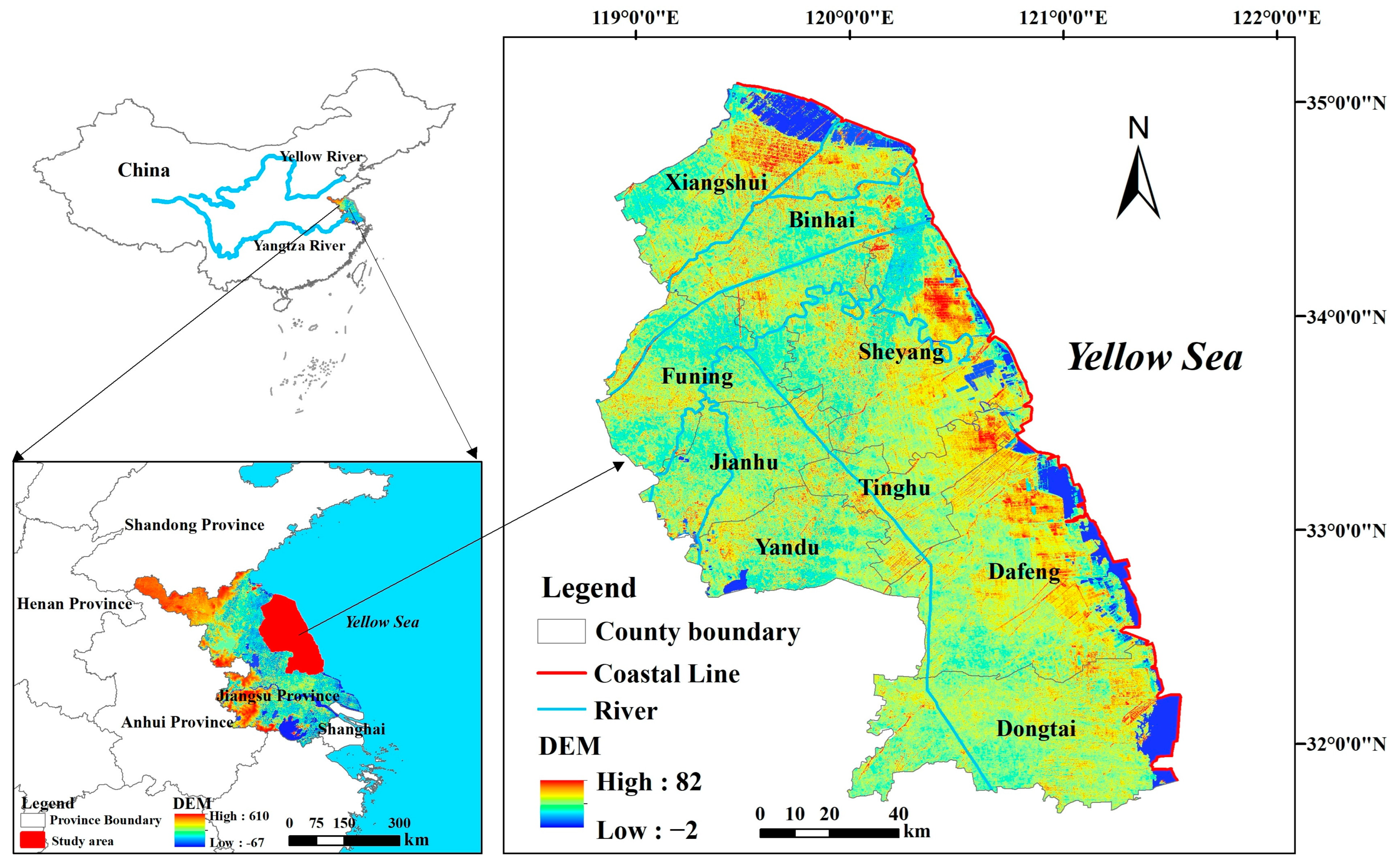
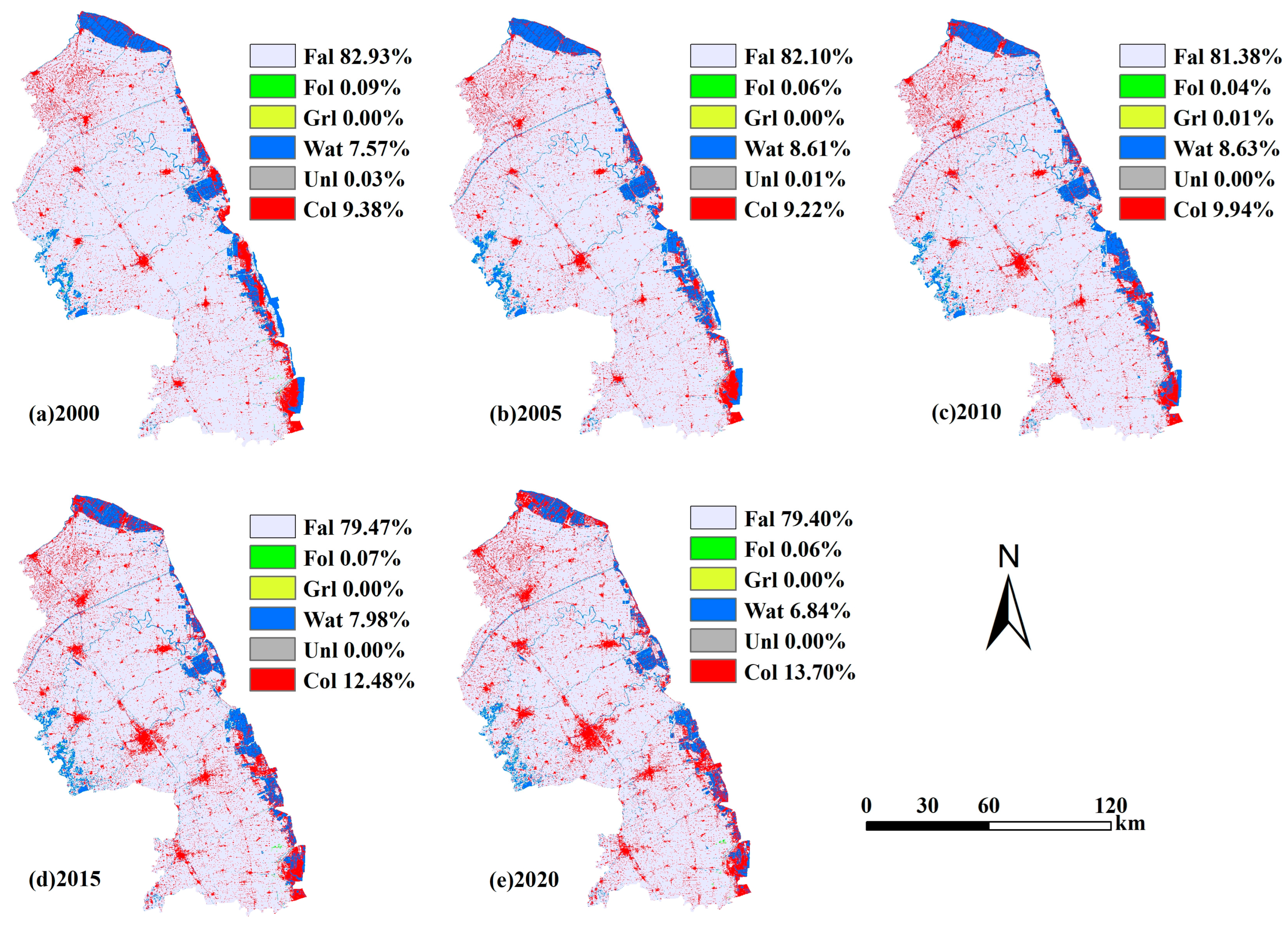


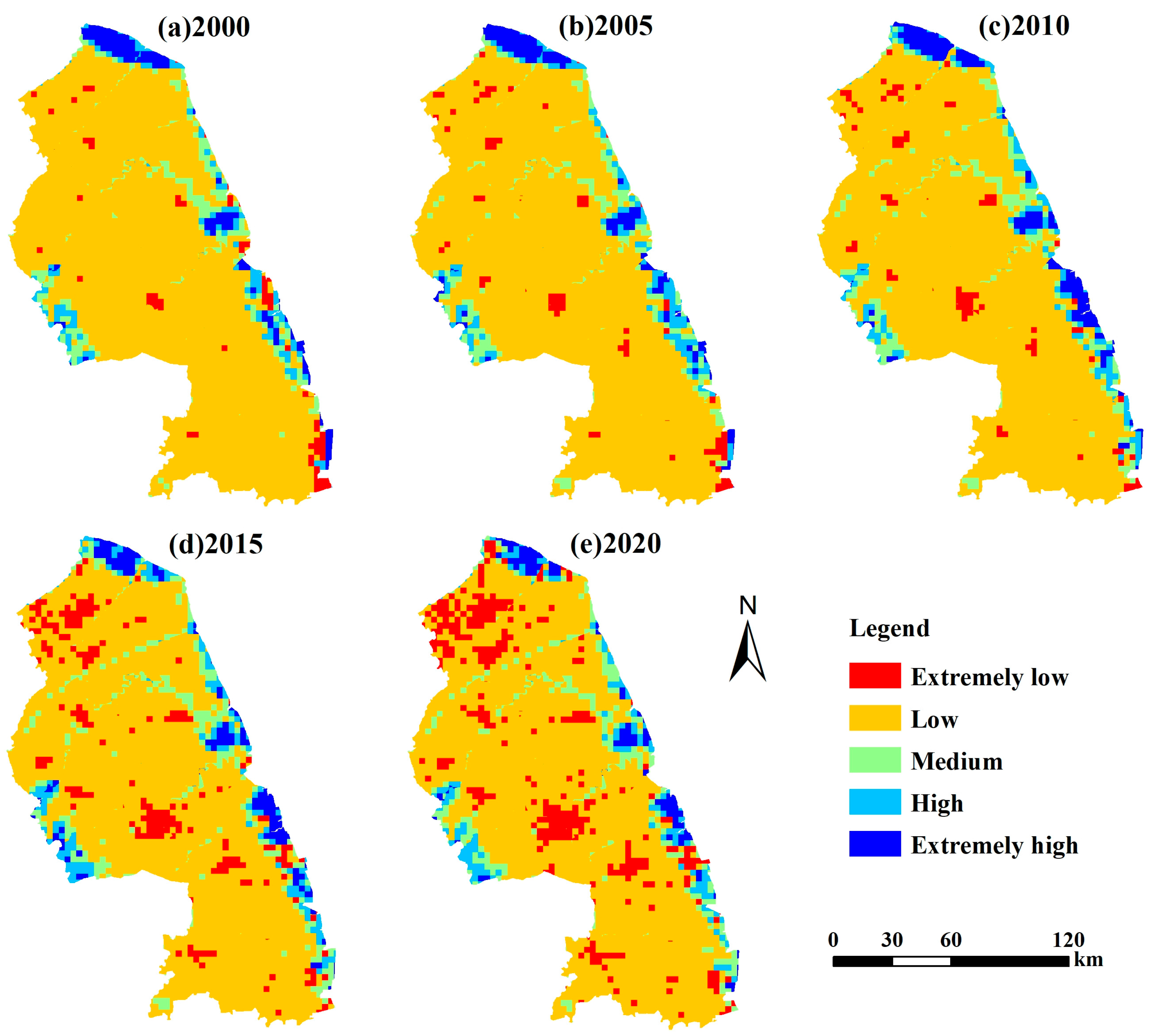
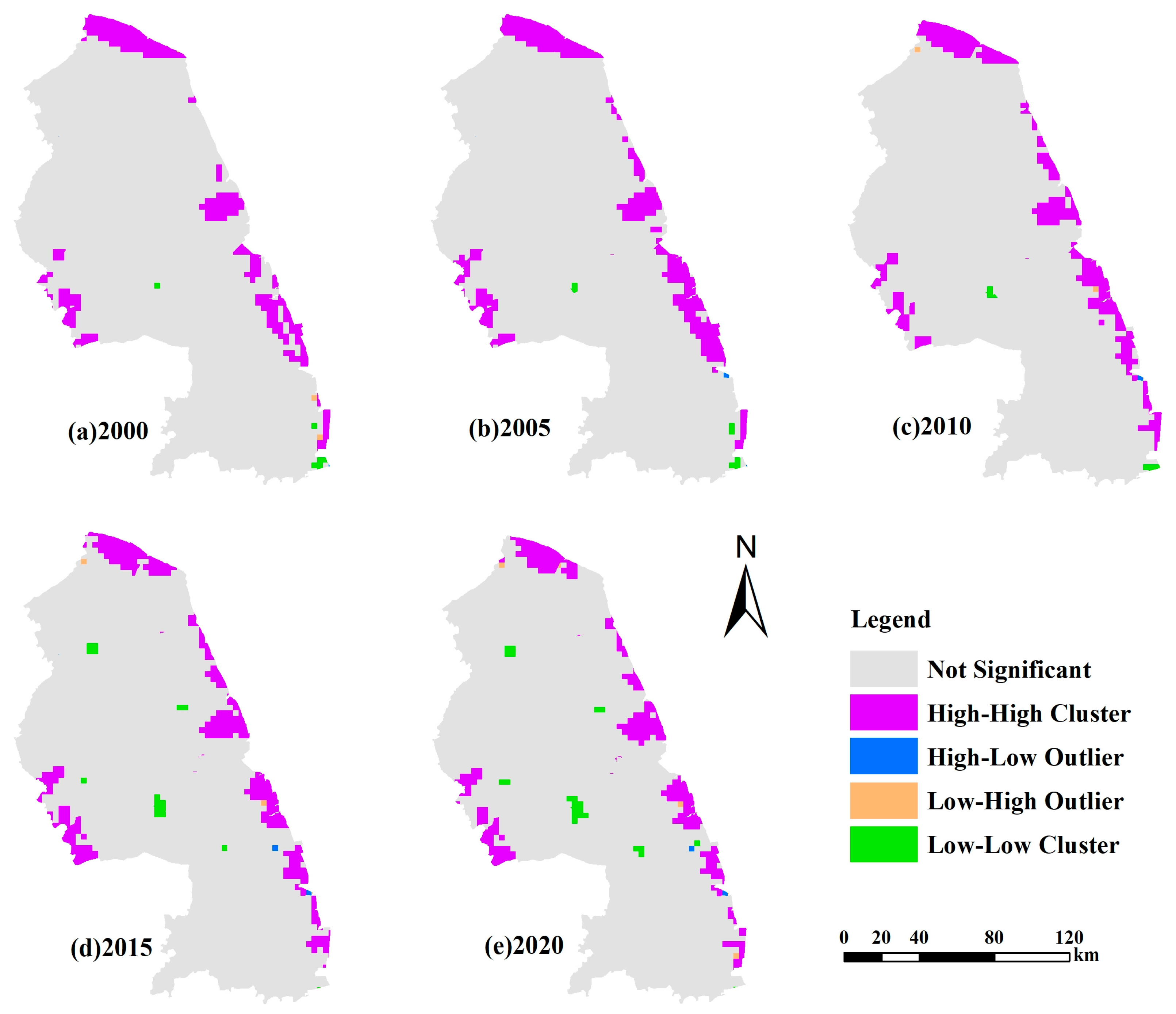
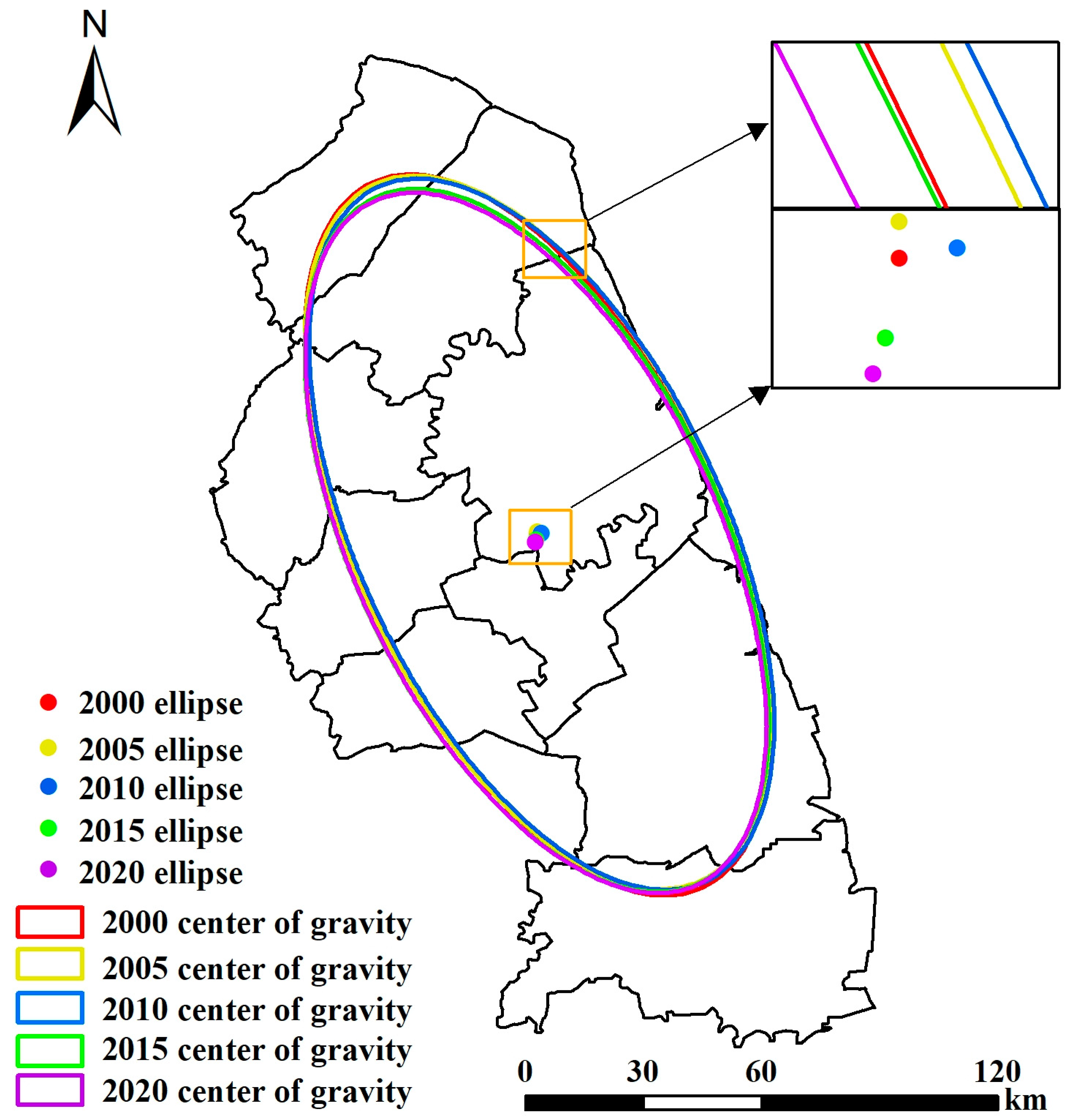
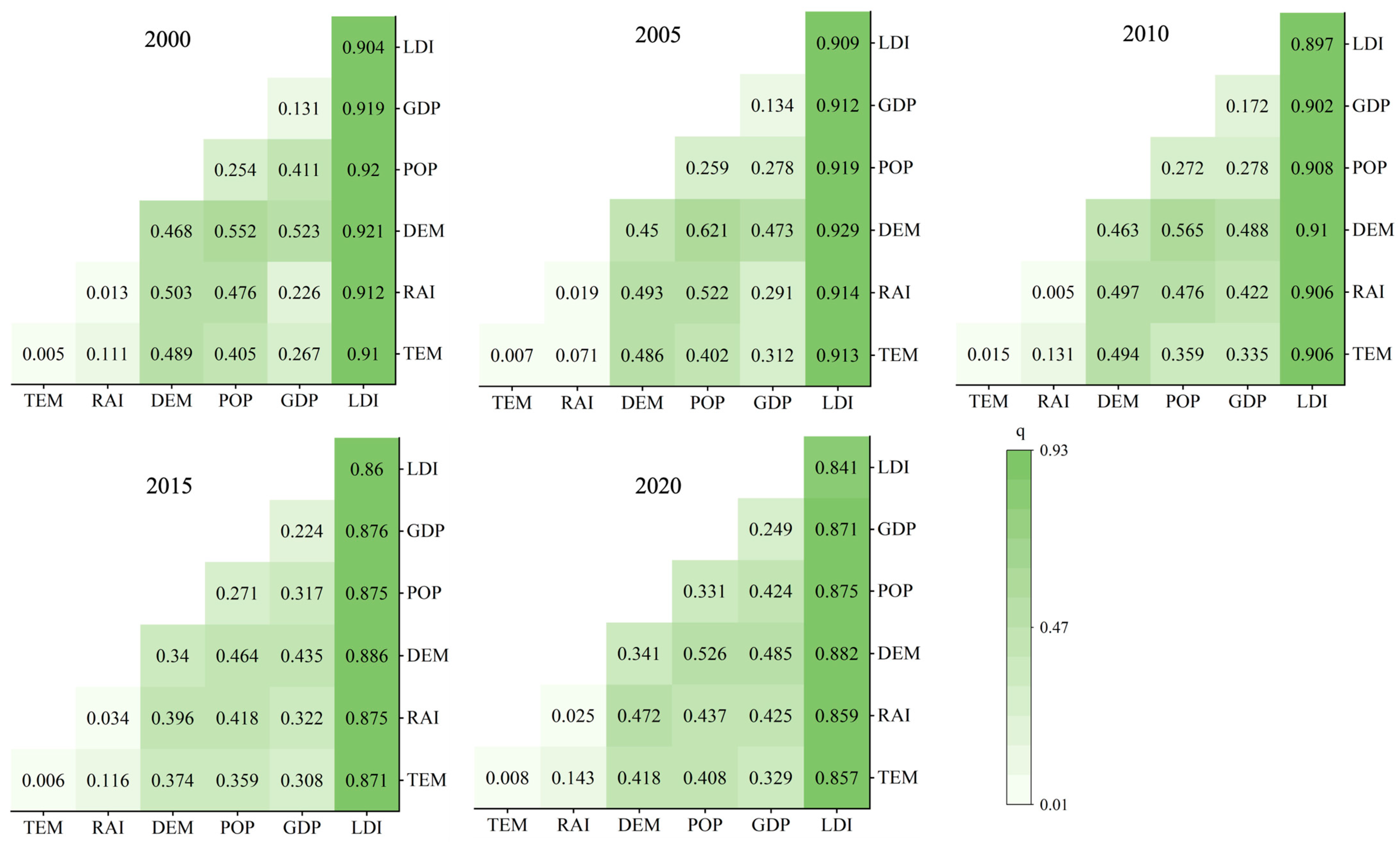
| Year | Type | Items | 2020 | ||||||
|---|---|---|---|---|---|---|---|---|---|
| Fal | Fol | Grl | Wat | Unl | Col | Transfer Out | |||
| 2000 | Fal | Area/km2 | 12,709.40 | 4.36 | 0.03 | 264.35 | 0.03 | 697.98 | 966.75 |
| Transfer out rate/% | 0.451 | 0.003 | 27.344 | 0.003 | 72.199 | 100.000 | |||
| Fol | Area/km2 | 8.20 | 5.18 | 0.00 | 1.37 | 0.00 | 0.40 | 9.97 | |
| Transfer out rate/% | 82.247 | 0.000 | 13.741 | 0.000 | 4.012 | 100.000 | |||
| Grl | Area/km2 | 0.47 | 0.00 | 0.02 | 0.16 | 0.00 | 0.15 | 0.77 | |
| Transfer out rate/% | 60.256 | 0.000 | 20.513 | 0.000 | 19.231 | 100.000 | |||
| Wat | Area/km2 | 311.16 | 0.19 | 0.00 | 697.77 | 0.08 | 240.79 | 552.22 | |
| Transfer out rate/% | 56.347 | 0.034 | 0.000 | 0.014 | 43.604 | 100.000 | |||
| Unl | Area/km2 | 1.56 | 0.00 | 0.00 | 2.21 | 0.15 | 1.49 | 5.27 | |
| Transfer out rate/% | 29.658 | 0.000 | 0.000 | 42.015 | 28.327 | 100.000 | |||
| Col | Area/km2 | 63.91 | 0.00 | 0.00 | 162.80 | 0.01 | 1319.50 | 226.72 | |
| Transfer out rate/% | 28.189 | 0.000 | 0.000 | 71.807 | 0.004 | 100.000 | |||
| Land Use type | Fal | Fol | Grl | Wat | Unl | |
|---|---|---|---|---|---|---|
| ESV (108 yuan) | 2000 | 357.81 | 1.43 | 0.03 | 188.54 | 0.02 |
| 2005 | 354.19 | 0.87 | 0.02 | 215.77 | 0.01 | |
| 2010 | 351.53 | 0.77 | 0.05 | 215.14 | 0.00 | |
| 2015 | 340.22 | 1.09 | 0.01 | 195.44 | 0.00 | |
| 2020 | 337.21 | 0.93 | 0.00 | 169.47 | 0.00 | |
| Changes rate (%) | 2000–2005 | −1.01 | −39.07 | −37.96 | 14.44 | −73.01 |
| 2005–2010 | −0.75 | −11.89 | 166.35 | −0.29 | −51.42 | |
| 2010–2015 | −3.13 | 40.98 | −71.67 | −9.16 | −36.95 | |
| 2015–2020 | −0.98 | −14.23 | −86.21 | −13.29 | −42.16 | |
| 2000–2020 | −5.76 | −35.09 | −93.55 | −10.11 | −95.22 | |
| Subtype | 2000 | 2005 | 2010 | 2015 | 2020 | 2000–2020 |
|---|---|---|---|---|---|---|
| Change Rate (%) | ||||||
| FS | 42.01 (7.67) | 46.69 (8.12) | 41.54 (7.32) | 40.35 (7.56) | 39.87 (7.81) | −5.10 |
| RMS | 21.45 (3.92) | 19.96 (3.47) | 20.69 (3.65) | 19.54 (3.66) | 18.41 (3.61) | −14.18 |
| GR | 35.54 (6.49) | 35.55 (6.18) | 35.19 (6.20) | 33.63 (6.30) | 33.75 (6.61) | −5.03 |
| CR | 53.56 (9.78) | 54.43 (9.47) | 53.96 (9.51) | 51.22 (9.60) | 50.61 (9.91) | −5.51 |
| HR | 114.60 (20.92) | 125.52 (21.84) | 125.20 (22.06) | 115.38 (21.62) | 105.13 (20.59) | −8.26 |
| WT | 126.54 (23.10) | 135.00 (23.49) | 134.40 (23.68) | 125.10 (23.44) | 117.48 (23.01) | −7.16 |
| SC | 69.63 (12.71) | 69.39 (12.07) | 68.78 (12.12) | 65.72 (12.31) | 66.35 (12.99) | −4.71 |
| MB | 61.64 (11.25) | 63.31 (11.01) | 62.82 (11.07) | 59.38 (11.12) | 58.04 (11.37) | −5.84 |
| EAC | 22.86 (4.17) | 24.95 (4.34) | 24.92 (4.39) | 23.42 (4.39) | 20.98 (4.11) | −8.22 |
| Index | 2000 | 2005 | 2010 | 2015 | 2020 |
|---|---|---|---|---|---|
| Global Moran’s I | 0.6646 | 0.6918 | 0.6589 | 0.6324 | 0.6169 |
| Z-score | 50.2452 | 52.2817 | 49.7993 | 47.7979 | 46.7941 |
| p-value | 0.0000 | 0.0000 | 0.0000 | 0.0000 | 0.0000 |
| Driving Factor | 2000 | 2005 | 2010 | 2015 | 2020 | |||||
|---|---|---|---|---|---|---|---|---|---|---|
| q Statistic | p Value | q Statistic | p Value | q Statistic | p Value | q Statistic | p Value | q Statistic | p Value | |
| TEM | 0.005 | 0.012 | 0.007 | 0.000 | 0.015 | 0.000 | 0.006 | 0.003 | 0.008 | 0.000 |
| RAI | 0.013 | 0.000 | 0.019 | 0.000 | 0.005 | 0.032 | 0.034 | 0.000 | 0.025 | 0.000 |
| DEM | 0.468 | 0.000 | 0.450 | 0.000 | 0.463 | 0.000 | 0.340 | 0.000 | 0.341 | 0.000 |
| POP | 0.254 | 0.000 | 0.259 | 0.000 | 0.272 | 0.000 | 0.271 | 0.000 | 0.331 | 0.000 |
| GDP | 0.131 | 0.000 | 0.134 | 0.000 | 0.172 | 0.000 | 0.224 | 0.000 | 0.249 | 0.000 |
| LDI | 0.904 | 0.000 | 0.909 | 0.000 | 0.897 | 0.000 | 0.860 | 0.000 | 0.841 | 0.000 |
Disclaimer/Publisher’s Note: The statements, opinions and data contained in all publications are solely those of the individual author(s) and contributor(s) and not of MDPI and/or the editor(s). MDPI and/or the editor(s) disclaim responsibility for any injury to people or property resulting from any ideas, methods, instructions or products referred to in the content. |
© 2023 by the authors. Licensee MDPI, Basel, Switzerland. This article is an open access article distributed under the terms and conditions of the Creative Commons Attribution (CC BY) license (https://creativecommons.org/licenses/by/4.0/).
Share and Cite
Zhang, X.; Shen, J.; Sun, F.; Wang, S.; Wan, Y. Spatiotemporal Distribution and Driving Force Analysis of the Ecosystem Service Value: A Typical Case Study of the Coastal Zone, Eastern China. Sustainability 2023, 15, 14172. https://doi.org/10.3390/su151914172
Zhang X, Shen J, Sun F, Wang S, Wan Y. Spatiotemporal Distribution and Driving Force Analysis of the Ecosystem Service Value: A Typical Case Study of the Coastal Zone, Eastern China. Sustainability. 2023; 15(19):14172. https://doi.org/10.3390/su151914172
Chicago/Turabian StyleZhang, Xiaoyan, Juqin Shen, Fuhua Sun, Shou Wang, and Yu Wan. 2023. "Spatiotemporal Distribution and Driving Force Analysis of the Ecosystem Service Value: A Typical Case Study of the Coastal Zone, Eastern China" Sustainability 15, no. 19: 14172. https://doi.org/10.3390/su151914172




